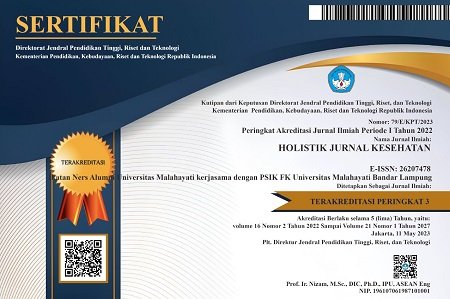Faktor – faktor riwayat ibu yang menyebabkan terjadinya stunting pada balita usia 6-59 bulan di Lampung Tengah
Abstract
Factors associated with stunting among children of age 6 to 59 months in Central Lampung, Indonesia
Background: Stunting is a chronic condition that describes the inhibition of growth for the long-term malnutrition, causing stunting is two directly and indirectly. Indirect causes are factors of education, history of the antenatal care (ANC), granting exclusive breastfeeding, maternal nutritional status, consumption of iron (Fe), occupational factors, and economic status.
Purpose: To determine the Factors associated with stunting among children of age 6 to 59 months in Central Lampung, Indonesia
Methods: Its quantitative descriptive cross-sectional design with total sampling. The sample is toddlers aged 5-59 months of 106 toddlers. The location was conducted in the village of Mataram Ilir, Seputih District, Surabaya, Central Lampung in 2019. Research instruments in the form of questionnaires, scales, Microtois/Staturmeter and midline. This research has passed research ethics with ethics number no. 62 / EC / KEP-UNMAL / 2019.
Results: There are of 54,2% of women not breastfeeding, 74.0% never pay attention for antenatal care during pregnancy, 71,9% of mothers suffer from chronic energy deficiency (CED), 52,1% of mothers never consume iron (Fe) during pregnant, and there were of 50.0% has a poor knowledge due to less education.
Conclusion: Factors of maternal of an indirect cause stunting is exclusive breastfeeding, consumption of iron (Fe), maternal nutritional status, history of the antenatal care and maternal education level can cause stunting to the children of age 6 to 59 Months.
Keywords: Socio-Economic; Maternal Nutritional Status; Stunting; Children of age 6 to 59 Months
Pendahuluan: Stunting merupakan kondisi kronis yang menggambarkan terhambatnya pertumbuhan karena malnutrisi jangka panjang, penyebab stunting terbagi dua yaitu secara langsung dan tidak langsung. penyebab tidak langsungnya adalah faktor pendidikan,riwayat ANC,Pemberian asi eksklusif , status gizi ibu,konsumsi zat besi (fe), faktor pekerjaan, dan status ekonomi keluarga
Tujuan: Untuk mengetahui faktor-faktor riwayat ibu yang menyebabkan terjadinya stunting pada balita 6 – 59 bulan di desa mataram ilir kecamatan seputih surabaya lampung tengah tahun 2019.
Metode: Penelitian deskriptif kuantitatif dengan rancangan cross sectional dengan menggunakan total sampling. Sampel penelitian adalah balita usia 5-59 bulan berjumlah 106 balita. Tempat penelitian dilakukan di desa Mataram Ilir , Kecamatan Seputih Surabaya, Lampung Tengah tahun 2019. Instrumen penelitian berupa kuesioner, timbangan, mikrotois dan midline. Penelitian ini sudah lulus etik penelitian dengan nomor etik no.62/EC/KEP-UNMAL/2019.
Hasil: Didapatkan 54,2% ibu yang tidak memberikan ASI Eksklusif, 74,0% ibu tidak melakukan perawatan ANC Saat hamil, 71,9 % ibu menderita KEK, 52,1% ibu tidak mengkonsumsi zat besi (Fe) saat hamil, dan terdapat 50,0 % ibu berpendidikan rendah.
Simpulan: Faktor-faktor riwayat ibu secara tidak langsung yang menyebabkan stunting yaitu pemberian ASI Eksklusif , riwayat konsumsi zat besi (Fe), status gizi ibu ,riwayat ANC dan tingkat pendidikan ibu dapat menyebabkan terjadinya stunting pada balita usia 6-59.
Keywords
Full Text:
PDFReferences
Aguayo, V. M., Badgaiyan, N., & Paintal, K. (2015). Determinants of child stunting in the R oyal K ingdom of B hutan: an in‐depth analysis of nationally representative data. Maternal & child nutrition, 11(3), 333-345.
Amaliah, N., Sari, K., & Suryaputri, I. Y. (2016). Panjang Badan Lahir Pendek Sebagai Salah Satu Faktor Determinan Keterlambatan Tumbuh Kembang Anak Usia 6-23 Bulan Di Kelurahan Jaticempaka, Kecamatan Pondok Gede, Kota Bekasi. Jurnal ekologi kesehatan, 15(1), 43-55.
Arini, L. D. D., & Firdaus, E. N. (2019). Pengaruh asupan dha dan protein pada ibu hamil terhadap berat badan dan panjang janin di rumah bersalin nissa tegalgede, karanganyar. Smiknas, 70-77.
Arisman, M. B. (2004). Gizi dalam daur kehidupan. Jakarta: EGC, 76-87.
Di Benedetto, M. G., Bottanelli, C., Cattaneo, A., Pariante, C. M., & Borsini, A. (2019). Nutritional and immunological factors in breast milk: a role in the intergenerational transmission from maternal psychopathology to child development. Brain, behavior, and immunity.
Elsandra, D. M., Made, I., Gunawan, A., & Joko, S. (2019). Kajian asupan kalsium dan sumber tanin pada kejadian anemia ibu hamil di kabupaten kulon progo tahun 2018 (Doctoral dissertation, Poltekkes Kemenkes Yogyakarta).
Haryono, R., & Setianingsih, S. (2014). Manfaat ASI eksklusif untuk buah hati anda. Yogyakarta: Gosyen Publishing, 1-30.
Maryunani, A. (2010). Ilmu kesehatan anak dalam kebidanan. Jakarta: Trans Info Media
Mesdaghinia, E., Naderi, F., Bahmani, F., Chamani, M., Ghaderi, A., & Asemi, Z. (2019). The effects of zinc supplementation on clinical response and metabolic profiles in pregnant women at risk for intrauterine growth restriction: a randomized, double-blind, placebo-controlled trial. The Journal of Maternal-Fetal & Neonatal Medicine, 1-7.
Mita, A. A., & Rina, O. (2019). Pendidikan orang tua, pengetahuan gizi ibu mengenai tumbuh kembang anak dan status gakin dengan kejadian stunting pada balita usia 24-59 bulan di wilayah kerja puskesmas karangmojo ii gunungkidul (Doctoral dissertation, Poltekkes Kemenkes Yogyakarta).
Oktadianingsih, D., Irianto, I., Chandradewi, A. A. S. P., & Jaya, I. S. (2019). Penambahan berat badan ibu hamil terhadap berat bayi lahir di kota mataram. Jurnal Gizi Prima, 2(2), 76-85.
Ophie, H. I. M. T., Made, I., Gunawan, A., & Tjarono, S. (2019). Kajian Asupan Protein dan Asam Folat Pada Ibu Hamil Anemia Di Wilayah Lokus Stunting Di Kabupaten Kulon Progo (Doctoral dissertation, Poltekkes Kemenkes Yogyakarta).
Pivina, L., Semenova, Y., Doşa, M. D., Dauletyarova, M., & Bjørklund, G. (2019). Iron Deficiency, Cognitive Functions, and Neurobehavioral Disorders in Children. Journal of Molecular Neuroscience, 68(1), 1-10.
Rainforth, M. (2019). The effect of maternal nutritional restriction on fetal development and performance of offspring in beef cattle. Alberta Academic Review, 1(2), 1-11.
Wahdah, S. (2012). Faktor Risiko Kejadian Stunting pada Anak Umur 6-36 Bulan di Wilayah Pedalaman Kecamatan Silat Hulu Kabupaten Kapuas Hulu Provinsi Kalimantan Barat (Doctoral dissertation, Universitas Gadjah Mada).
Walker, S. P., Wachs, T. D., Grantham-McGregor, S., Black, M. M.,
Nelson, C. A., Huffman, S. L., & Gardner, J. M. M. (2011). Inequality in early childhood: risk and protective factors for early child development. The lancet, 378(9799), 1325-1338.
Wellina, W. F., Kartasurya, M. I., & Rahfiludin, M. Z. (2016). Faktor risiko stunting pada anak umur 12-24 bulan. Jurnal Gizi Indonesia (The Indonesian Journal of Nutrition), 5(1), 55-61.
Word Health Organization. (2014). Sasaran Gizi Global Ringkasan Kebijakan Pendek. Jenewa: Kesehatan Dunia Organisasi. Universitas Airlangga. Surabaya.
Ye, A., Yan, S., Huang, K., Mao, L., Ge, X., Weng, T., & Tao, F. (2019). Maternal intelligence quotient and motor development in early childhood: The mediating role of mother's education. Journal of paediatrics and child health, 55(1), 87-94.
DOI: https://doi.org/10.33024/hjk.v13i4.2062
Refbacks
- There are currently no refbacks.
Copyright (c) 2019 HOLISTIK JURNAL KESEHATAN

This work is licensed under a Creative Commons Attribution-NonCommercial 4.0 International License.














